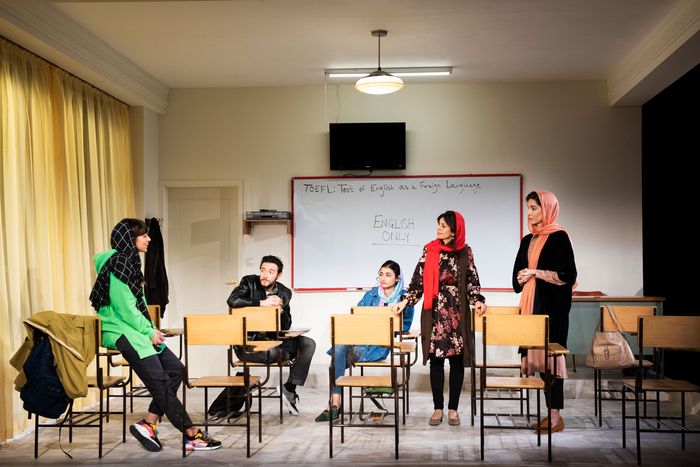
D.H. Lawrence wasn’t known for his plays: It’s hard to keep up a reputation for theater when you’re rarely produced and your other writing is busy ripping the starched shirt off British censorship. Over the past two decades, though, the Mint Theater has looked closely and carefully at Lawrence’s portraits of domestic life near the Lincolnshire mines. They’re not as heated as novels like Sons and Lovers or Lady Chatterley’s Lover; instead, his dialect-filled plays contain a certain magnetic, sooty darkness. In 2003, the Mint produced Lawrence’s 1913 drama The Daughter-in-Law; in 2009, it was the bleaker The Widowing of Mrs. Holroyd. Now they return to The Daughter-in-Law, a strange and compelling portrait of a misalliance.
The marriage between Minnie (Amy Blackman) and miner Luther Gascoyne (Tom Coiner) is only seven weeks old, but it’s already bubbling with betrayal and class-confusion. Luther’s overbearing mother (Sandra Shipley) finds out that her son has impregnated a local girl just before the wedding, and she seems oddly delighted that, when the news gets out, her daughter-in-law’s honeymoon sweetness will rot. The reasons for her hatred are complicated, rooted in Minnie’s pretensions — her educated speech sets her apart, as does her little nest egg. The other girl’s mother (Polly McKie) is willing to accept £40 to bury the scandal; Mother Gascoyne purrs with jealous pleasure at the idea that Minnie will be the one to pay.
This would normally be when the marriage explodes, but Lawrence makes Minnie a tank. Minnie cuts off her own escape routes from the marriage, hoping that Luther will discover a kind of foxhole solidarity with her. The anti-romantic show’s pleasures are dark ones and are sometimes deliberately obscure; its realism depends entirely on the cast’s comfort with the East Midlands dialect, which can be difficult to understand. Here, coached by Amy Stoller (also the production’s dramaturg), the cast sounds marvelous, their pronunciations tarred and sticky as old molasses.
Martin Platt (who also directed in 2003) presides over a fine production, realized precisely by costume designer Holly Poe Durbin, set designer Bill Clarke, and composer Lindsay Jones. For a while I wondered Why revive it again? Lawrence’s drama clenches you tight with anxiety, then lets you go. Perhaps Platt wanted post-quarantine viewers to feel that vicarious escape again? But I think the Mint may have chosen to unpack The Daughter-in-Law from the trunk because they had the cast for it. The text is performed nicely by the men, but it is detonated by the women. McKie and Shipley’s first scene is gorgeous: The two mothers sip tea at the kitchen table, comfortably gossiping and plotting as they tear their children’s romantic ideas to shreds. They are funny and awful and superb. More important, though, is Blackman: Tall and elegant, steady-handed and radiant with thought, she can make even Lawrence’s wilder turns seem like penetrating insights. The men may be swinging their axes at the coalface, but she’s down in the play’s psyche, delving for the deeper ore.
Many of the same issues of language and the divided self wind through Sanaz Toossi’s English, now at the Atlantic Theater. In Lawrence’s play, speakers of the two languages — the Midlands dialect and a more urban and educated English — cannot ever quite understand each other. In Lawrence’s view, you trade off: If you speak the city-English, you wind up a different person, and a bridge to your village-self burns behind you. Toossi is also interested in the effect of bilingualism on a psyche, though she’s more ambivalent. Do you change your personality, too, when you change languages? Lawrence was certain that you do; Toossi still wonders.
In an English class in Iran, Toossi’s characters consider the benefits of letting another language into their minds. On the surface, they’re desperate to do it. Their teacher Marjan (Marjan Neshat) is preparing them for an exam, and she asks them to speak only English in class to help attain fluency. Omid (Hadi Tabbal) acquiesces easily; young Shakira-enthusiast Goli (Ava Lalezarzadeh) struggles; competitive Elham (Tala Ashe) chafes. The oldest student, Roya (Pooya Mohseni), rebels. On the phone, Roya’s own emigré son seems different to her in English — he only asks after her welfare when they’re speaking Farsi. Unwilling to substitute the unfeeling, hooting English sounds for the elegance of her mother tongue, Roya eventually turns her back, first on Marjan, then on the class.
Toossi’s drama is one of microscopic shifts — there might be something romantic between Omid and Marjan, but it’s never clear. (In fact, Omid’s motivations are baffling and only become more so.) The actors use an accent when they speak in English, then drop it to signal a shift into Farsi. The play, like a language lesson, is therefore full of games; it requires humor (Lalezarzadeh nails this) and a sure step. But although Knud Adams’s production looks gorgeous — Marsha Ginsberg sets them inside a huge rotating classroom that responds to Reza Behjat’s lighting like a sculpture — its pace is too lugubrious for Toossi’s quickfoot dramaturgy. Between scenes, Adams has the sound designer, Sinan Refik Zafar, pipe in Western-style classical music to emphasize that we are dealing with big emotions, which slows and deadens the space. Toossi is asking us to listen to subtle shifts, entire histories of empire hidden inside mere pronunciation. Here these grace notes are drowned out by a lack of subtlety — they are little shades of meaning swept away, wrongly conjugated, lost to mistranslation.
The Daughter-in-Law is at City Center through March 20.
English is at the Atlantic Theater Company through March 20.



